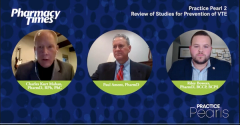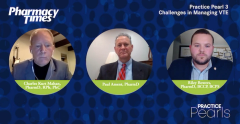
Identifying the Rate of VTE Postdischarge
Episodes in this series

Paul Ament, PharmD, and Charles Mahan, PharmD, RPh, PhC, review the rates of VTE postdischarge from a hospital.
Charles Kurt Mahan, PharmD, RPh, PhC: Let’s shift into the rates of VTE [venous thromboembolism] after discharge after hospitalization, and maybe we’ll also discuss some of the thromboprophylaxis patterns we’re seeing in the United States.
Paul Ament, PharmD: When I do the resident lecture on VTE prophylaxis, I start by asking for a show of hands of how many have initiated thromboprophylaxis in the medical patient, and everybody’s hand goes up. Then I’ll ask a question about how many have continued thromboprophylaxis postdischarge, and nobody’s hand goes up. I kid with them when I say, “You have that much magical power in your discharge order that thromboembolic risk magically goes away?”
We’re aggressive and very much attuned to inpatient thromboprophylaxis. Within my institution [Excela Health], we are on the Cerner electronic health record, and we have a pathway. It’s a program called VTE Advisor that overlays in Cerner. With any admission, the clinician can’t even bypass risk stratifying the patient through VTE Advisor. What I share with them is that over 50% of the clots occur postdischarge.
Even in the data that Dr Alpesh Amin had published in the Journal of Hospital Medicine, when they looked at a 90-day period postdischarge, the majority of clots, almost 70%, occurred within the first 30 days. From your second month, it was then about 20%, and it was down to about 10% during that third month. It illustrates that we need to find and risk stratify some of these highest-risk patients on discharge. We are discharging patients quicker and sicker, and their risk doesn’t go away just because an escort wheels them out of the hospital.
Cancer, immobility, age, as well as an early history of VTE are going to be some of the greatest factors for thromboembolic risk into the outpatient setting. Dr Mahan, who is the moderator, published a nice article in Thrombosis Research several years ago. It was a huge study of 141,000 patients, and what he documented was that we have a lot of room for improvement in VTE prophylaxis. In this population, only about 40% received prophylaxis, but you also concluded that thromboprophylaxis does not reduce the risk of discharge or thromboembolic phenomenon in the outpatient setting. I believe he cited that only about 4% of patients continue on thromboprophylaxis in the outpatient setting.
Charles Kurt Mahan, PharmD, RPh, PhC: Those are some great points. You also brought up an important point earlier that lengths of stay have changed. It was a 10-day length of stay for an infection or CHF [congestive heart failure] that Riley brought up, but now in the medical patients, we’re having an average of a 2- to 3-day length of stay for many of these patients. They may be getting 1 to 2 shots or doses of an oral anticoagulant inpatient, and then they’re out the door. One of the theories behind that is that things have changed so much that minimal inpatient prophylaxis is not having any effect on postdischarge venous thromboembolism now.
Exactly as you’ve pointed out, Dr Amin published similar data showing only about 2% of patients get postdischarge prophylaxis, but we are at highest risk during the first 30 days after hospitalization, and about 50% to 60% of the VTE, at a minimum, occur within that 30-day period. That’s why several pharmaceutical companies pursued that window with 30 to 45 days being highest-risk period for the development of venous thromboembolism.
Newsletter
Stay informed on drug updates, treatment guidelines, and pharmacy practice trends—subscribe to Pharmacy Times for weekly clinical insights.






















































































































































































































